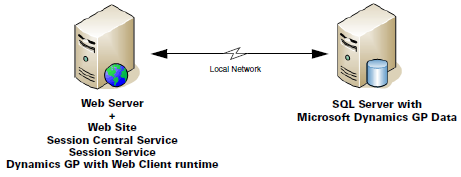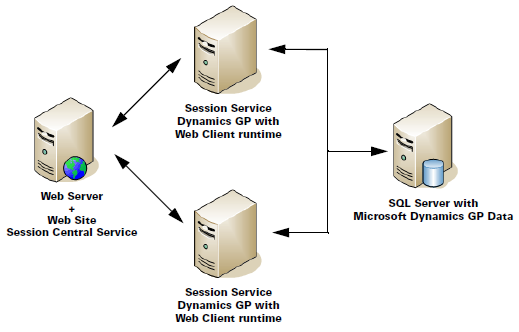 The first post in this series was a brief introduction which outlined the components within a web client deployment which I’m going to follow up in this post with a look at the deployment options which are available.
The first post in this series was a brief introduction which outlined the components within a web client deployment which I’m going to follow up in this post with a look at the deployment options which are available.
There are three options when deploying the Microsoft Dynamics GP web client:
- Single machine
- Scale out
- Multi-tenant
The single machine configuration is the simplest configuration available when deploying the Microsoft Dynamics GP web client. In this configuration, the web site, Session Central Service, Session Service and the Microsoft Dynamics GP web client runtime are all installed on a single server.
A typical single configuration machine is shown in the following diagram;

This configuration is used when there will not be a lot of users accessing the system and will also commonly used by developers and consultants such as myself when building development or test systems. The coming series of posts will be done using a single machine deployment although when the RTM of Microsoft Dynamics GP 2013 is available I will be installing a scale out configuration.
The scaler out configuration would be used when the deploying organisation has a larger number of users who will be accessing the Microsoft Dynamics GP web client/
In this configuration, there is one server which contains the web client and Session Central Service and two or more session host machines which will all contain the Session Service and Microsoft Dynamics GP web client runtime. The Session Central Service will load balance the processing between the session host machines.
The below diagram shows the typical scale out configuration;

The final configuration type, is the multi-tenant configuration which will typically be used by orrganisations who are hosting Microsoft Dynamics GP for other customers. This configuration can support a high number of users.
In this configuration, there will be multiple front-end web servers, each running the Session Service, and can be load-balanced. Multiple session host machines host the sessions of the Microsoft Dynamics GP web client, each of which contains the Session Service and Microsoft Dynamics GP web client runtime. The Tenant Service is used with this configuration to allow multiple Microsoft Dynamics GP installations to be run on the same physical service.
In the next post, I’ll take a look at configuring the Microsoft Dynamics GP installation to support the web client.





5 thoughts on “How To Install The Microsoft Dynamics GP 2013 (Beta) Web Client – Deployment Options”